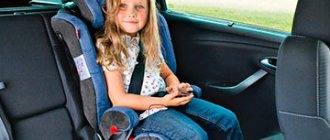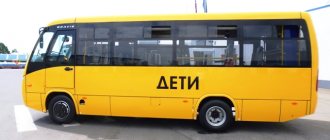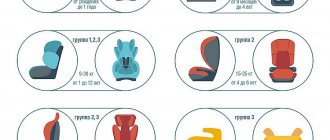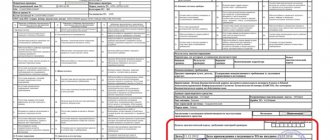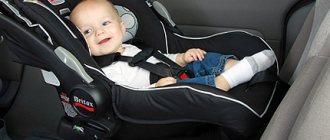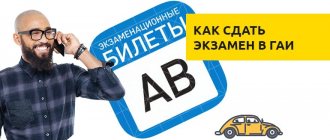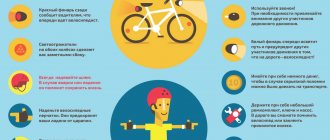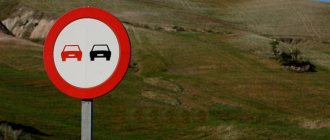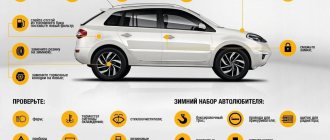What is a booster for children
A booster seat for children is a type of car child restraint system (CAC).
The main purpose is to artificially increase the height of a child in a sitting position to secure him with a standard seat belt, the standard design of which is designed for a person with a height of 150 cm.
The main function of a booster seat for children is to increase the safety of transporting children without the use of a full-fledged restraint device, which is achieved by complying with the following conditions:
- fixing the child’s position in the event of a possible collision using a stationary attachment of the pillow at three points;
- correct direction of the car seat belt - over the shoulder and hips;
- quick disembarkation of the child from the cabin.
It is an ergonomic seat with armrests, does not have a backrest or side protection, and uses the back of a car seat as a support. Subject to mandatory certification in accordance with GOST R 41.44 - 2005. or with the UNECE European Safety Standard No. 44-04.
It is allowed to place the booster in the direction of travel on the front or rear seats in accordance with the requirements of the operating manual for each individual device.
What is a booster?
A child car seat - a booster - belongs to the category of travel devices designed to ensure the safety of a small passenger during a trip. Moreover, it differs from a regular chair in such factors as:
- lack of backrest;
- There are no specific seat belts included;
- smaller size and weight.
Child booster seats (description):
- seat equipped with armrests;
- The device is secured with a car seat belt.
At what age can a booster be used?
In accordance with clause 22.9 of the Traffic Regulations of the Russian Federation, the transportation of children is permitted:
- up to 7 years old - only using a child restraint system;
- from 7 to 11 years old - in the front seat - only with a child restraint system, in the rear - it is allowed to use only standard seat belts, without additional devices;
- from 12 years old - only seat belts are allowed.
In addition, the rules establish that each of the devices used must correspond not only to the age, but also to the weight and height of the child.
Depending on the age and weight of the child, in accordance with UNECE No. 44-04, all restraint devices are divided into groups:
- 0 – from birth to 6 months and weighing up to 10 kg;
- 0+ – from 6 to 12 months (up to 13 kg);
- I (1) – from 9 months to 4 years (9 – 18 kg);
- II (2) – from 3 to 7 years (15 – 25 kg);
- III (3) – from 6 to 12 years (22 – 36 kg).
A child booster seat without a backrest, in accordance with the amendment made to the UNECE Uniform Regulations No. 44-04 in 2021, can only be used as a restraint structure for group III (3).
Thus, it is allowed to use a booster to transport a child aged 6 to 12 years only in the back seat of a car, and its weight must be between 22 and 36 kg, and its height must be at least 125 cm.
In this case, you should consider the option of a booster when transporting a child over 12 years of age, provided that his height is less than 125 cm, since the standard seat belt should be at shoulder level and in no case in the neck area.
What do the 2021 traffic rules say?
The last time the Rules were adjusted regarding the issue of transporting children and boosters, in particular, was in July 2021. And then clause 22.9, which regulates the rules of transportation, became even more confusing. There is no specific mention of any device:
- no child seat
- no booster in the context of the child’s age,
- nor any kind of adapters or other devices.
There are only two common vague terms:
- child restraint,
- child restraint system.
At the same time, it is not said whether these are the same thing or different devices for transporting children.
22.9. Transportation of children under the age of 7 years in a car and truck cab, which are designed with seat belts or seat belts and an Isofix child restraint system, must be carried out using child restraint systems (devices) that are appropriate for the weight and height of the child.
The name of the ISOFIX child restraint system is given in accordance with the Technical Regulations of the Customs Union TR RS 018/2011 “On the safety of wheeled vehicles”.
Transportation of children aged 7 to 11 years (inclusive) in a passenger car and truck cab, which are designed with seat belts or seat belts and an ISOFIX child restraint system, must be carried out using child restraint systems (devices) that are appropriate for the weight and height of the child , or using seat belts, and in the front seat of a car - only with the use of child restraint systems (devices) corresponding to the weight and height of the child. The installation of child restraint systems (devices) in a passenger car and the cabin of a truck and the placement of children in them must be carried out in accordance with the operating instructions for the specified systems (devices).
It is prohibited to transport children under the age of 12 on the back seat of a motorcycle.
So, we see that there is a gradation according to the child’s age and rules for transportation in the back and front seat of a car:
- up to 7 years - both in front and behind only using child restraints,
- from 7 to 11 years old - only with child restraints in front, can be fastened with a seat belt in the back,
- From 12 years old you can wear a seat belt.
You will also be interested in:
- Can frameless child car seats be used in a car? From what age?
- Fines for violations of the rules for transporting passengers in situations
- A child in the front seat - at what age can you drive under the new law?
Booster markings
When choosing a booster, you should pay attention to its markings; if there are no markings, it is better not to buy such a booster. The marking, or simply the sticker label, carries important information.
Labeling of a children's booster is carried out in accordance with UNECE No. 44-04 and must have the following designations:
- color – orange or white;
- ECE-R44/04 – mark of product compliance with the safety standard;
- 22 – 36 – user weight category;
- 04 and further six-digit code – individual number of tests performed;
- E1-9 – a sign of official safety approval provided by one of the European countries;
- III – retention device group (Roman or Arabic numerals can be used).
Recently, booster packs were labeled “2/3”, indicating that the booster is designed for a child weighing from 15 to 36 kg. Nowadays, the use of boosters is prohibited for such young children, since their spine is not yet strong and they need lateral support. The booster is approved for the age group designated “3”, that is, for children weighing from 22 kg and height from 125 cm. The “2/3” marking is outdated and was canceled in 2017.
Can a booster be used at what age of a child?
Let's return to our main question about the possibility of placing a child in a booster seat - at what age can this be done according to traffic rules in 2021? To answer, we need to understand what a booster is by law. And the Rules refer us to the Technical Regulations.
Looking at the latter, we understand that the child restraint system must comply with UNECE Regulations No. 44-04 (Appendix No. 10 - “List of requirements for types of vehicle components”). If your booster meets these requirements, then you can transport your child in the booster.
Finding out about such compliance is quite simple: there should be a corresponding marking on the label on the booster itself. In this case, 2 options for representing the notation are possible:
- Russian-made boosters are, as a rule, marked “UNECE No. 44-04” or “GOST R 41.44-2005” (the latter GOST is the Russian version of the UNECE Rules),
- Imported boosters are most often marked as “ECE R44/04” - this also means that the device meets the requirements of the Economic Commission for Europe.
Boosters with this marking can transport children of any age. In very rare cases, boosters may not have any markings on the case at all, but only in the documents. In this case (and in general always), when purchasing, you should request a certificate of compliance with the above rules. Otherwise, you may be legally fined.
Expert opinion
Yuri Panchenko
Driving instructor, human rights activist, author of books. 10 years of experience.
As correctly stated in the article, the requirements for child restraints are regulated by UN Regulation No. 44-04.
GOST R 41.44-2005 has lost force since 01/01/2018, but if the child seat indicates the date of manufacture before the specified date, and there is a plate of compliance with GOST R 41.44-2005, then there should be no claims from the traffic police.
The use of boosters is governed only by UN Regulation No. 44-04. They must also have a conformity label. Moreover, the booster must be manufactured after 02/09/2017, when the relevant amendments entered into force. This device is used for children with a height of 125 to 150 cm and a weight of 22 to 36 kg.
If a child is taller than 150 cm or weighs more than 36 kg, then there are no child restraints for him. Then we fasten the child with a regular standard seat belt in the back seat.
Ask a Question
Booster material for children
The material used in the production of the booster determines its strength, long-term use and cost.
From foam plastic
Foam boosters have the following advantages:
- do not get wet;
- resistant to microorganisms (can be stored in a cold and damp place);
- have a small weight - up to 2 - 3 kg;
- have a low cost - up to 1000 rubles.
As a disadvantage, it is necessary to note the fragility of the material, and, as a result, the low level of protection, since when exposed to force, the foam does not hold its shape and crumbles.
Made of plastic
Boosters made of plastic have all the advantages of foam and are relatively cheap - their cost is 1500 - 2000 rubles. During sudden braking, they reliably hold the child in a fixed position, but in the event of an accident, an additional risk may arise - the material breaks into thin and sharp parts.
With metal frame
The disadvantages of a booster with a metal frame are its heavy weight and overall dimensions, but they do not matter when compared with the advantages:
- high degree of protection;
- resistance to impact;
- reliability of fixation.
In addition, such a booster has increased comfort, since its interior consists of several layers of polyurethane foam, which retains the shape of the body and gives softness.
Pros and cons of boosters
Using a baby booster undeniably has some advantages:
- comfortable placement of a child, especially at the age of 10 - 12 years;
- low cost - from 700 to 3000 rubles. depending on the material of manufacture;
- compactness;
- light weight – up to 5 kg;
- ease of installation and dismantling.
The booster has one drawback, but it plays a decisive role when choosing a child restraint system - the level of protection in the event of a possible accident is significantly lower compared to a child car seat due to the lack of lateral impact protection.
How to choose a booster
When choosing a child booster, it is necessary, first of all, to focus on the safety, reliability and comfort of placing a child in the cabin.
Frame material
The frame material is hard: metal or plastic. In this case, the following conditions must be met:
- the pillow filler should be soft and hold the shape of the body;
- the surface of the seat should be evenly covered with ergonomic filler;
- The leading edge of the booster should be soft and sloping.
In addition, there are no obvious frame protrusions around the entire perimeter of the device that would impact a child under normal conditions.
Case material
Preferred characteristics of the cover material: wear resistance and hypoallergenicity. The use of natural fabrics that do not cause sweating and are able to absorb moisture increases the child’s comfort in hot weather. The removable cover guarantees timely cleaning and washing.
Armrests
The metal frame of the armrests should be covered with soft filling to create comfort. To reduce the risk of injury, the only condition must be met: the height of the armrest must correspond to the free position of the child’s arm, bent at a right angle.
Dimensions
The overall dimensions of a booster seat for children must correspond to the size of the child, since this is the basis for safe transportation:
- The length of the seat should be equal to the length of the legs with bent knees with full contact between the child’s back and the back of the car seat. If the length of the booster is longer, the child’s legs will be straightened, which is contrary to safety conditions. In addition, by bending his legs, the child will roll his back along the back of the car seat, which will lead to the seat belt moving from the shoulder to the neck or head - this position is strictly unacceptable. A similar situation will arise if the length of the seat is shorter - the lack of comfort will encourage the child to slide down the back.
- The width of the booster should correspond to the size of the child, taking into account the presence of warm clothing. Squeezing the body will cause pain, and the presence of free space will not allow you to securely fix the position.
Thus, before purchasing, it is advisable to place the child on the booster and check the compatibility of the sizes.
Seat belt corrector
The corrector is used to prevent the seat belt from moving in the event of an emergency. It is a triangular envelope that pulls two standard belts together. Required when the belt strap slips off the child’s shoulder and does not return spontaneously.
It can be used in extreme cases as an additional measure in conjunction with a booster, but is not an independent restraint device, since it shifts the calculated load on the belt and weakens its tension.
Mounting method
The safest way to secure a child booster seat in the cabin is the ISOFIX or LATCH system. It is certified and allows you to securely fix the booster on the car seat.
It is allowed to place the booster in the cabin using seat belts without additional fastening, however, this significantly increases the risk of injury in the event of an emergency.
Child's opinion
The child’s opinion is an important factor when choosing a booster, since only he himself will identify possible inconveniences in use:
- the presence of protruding parts of the frame;
- hardness or excessive softness of the seat;
- squeezing on the sides.
In addition, during testing it is necessary to check the compliance of the armrests and seat length with the child’s size, and also to identify the need to adjust the seat belt.
Car seat, booster or adapter?
The safest and most effective are a car seat and an infant carrier (for children under one year old). The position of the child car seat also reduces the risk of injury by almost 80% - at least until the age of four, the child should sit against the direction of travel.
The choice of the type of child car seat is primarily influenced by the height and weight of the child. In 2007, based on World Health Organization calculations, five categories were developed to help parents make choices:
0 (for babies weighing less than 10 kg),
0+ (13 kg), I (9 - 18 kg), II (15 - 25 kg), III (22 - 36 kg).
In addition to car seats, there are other types of restraint devices on the market. For example, boosters (seats without a backrest), as well as belt overlays, which allow you to slightly move the belt down so that it has a more correct position on the child’s body.
Manufacturers of boosters and pads position their products as a cheap alternative to a child car seat. However, these devices do not take into account all the physiological characteristics of the child, and therefore do not provide the proper level of safety and, on the contrary, can sometimes even harm the little person.
Boosters are often made from low quality plastic or foam that splits in half during an accident. Not only is such a “restraint device” unable to absorb the force of the impact in the event of a collision, but the child will most likely be seriously injured by its fragments. Boosters consisting of a metal base, polyurethane and a soft layer are considered stronger, but can only protect adult children; they are not suitable for the smallest passengers. By the way, in developed countries the use of boosters is strictly prohibited, since the lack of a backrest and proper fixation jeopardizes the health and safety of the child.
There is no question of buying adapters that lower the diagonal and raise the lower strap of the basic seat belt. When using this pseudo-analogue of a child car seat, the entire load goes to the chest, and in the event of an accident, the child receives serious damage to internal organs. It is noteworthy that in some countries the installation of such devices is punishable by up to the deprivation of a driver’s license.
However, even purchasing a car seat does not guarantee the safety of your child. According to expert data, 80% of child car seats imported into Russia in 2015 were imported from China. Most of them do not meet mandatory security requirements and do not guarantee anything other than a formal opportunity to evade a fine. This is confirmed by the results of a number of special checks. During production, they use low-quality materials and plastic fasteners, so in the event of an accident, the child receives even more serious injuries than without a car seat at all.
Legislative regulation in this area has been addressed at the highest state level. The importance of child safety issues was outlined by the President of the Russian Federation Vladimir Putin at a meeting of the Presidium of the State Council on Road Safety in March this year. In August, the problems of regulating the passenger transportation of children were brought up for discussion in the Open Government format at a meeting with Minister Mikhail Abyzov. The government drew attention to the need to improve the child restraint certification procedure and prepare methodological materials to help parents choose a car seat. Following the meeting, the minister prepared a number of instructions.
“It is proposed to exclude from the traffic rules the possibility of using for the transportation of children “other means that allow fastening a child using seat belts provided for by the design of the vehicle,” which do not provide the proper level of protection for the child. And, moreover, they are highly likely to aggravate the consequences of an accident for a child compared to standard seat belts used to secure a child without any additional devices,” said Vladimir Kuzin, Deputy Head of the Main Traffic Safety Inspectorate of the Ministry of Internal Affairs of the Russian Federation. — “Under 7 years of age, children still must be transported in a car only in a car seat. The new amendments also allow that at the age of 7 to 11 years, a child, if his physiological parameters no longer fit into a car seat and sits in the back, will be able to fasten himself using regular seat belts. Requirements for the use of a child restraint will remain if such a child is placed in the front seat.”
Safety: differences between a booster and a car seat
Comparative characteristics affecting safety are given in the table:
| Index | Car seat | Booster pillow |
| Fastening | 5 points | 3 points |
| Rigid back for impact protection | There is | No |
| Side protection | There is | No |
| Head protection | There is | No |
| Fixation | tough | medium or low |
Thus, a car seat is a safer way to transport a child. It is recommended to buy and use a booster in the following cases:
- if the child is large and it is not possible to choose a chair;
- upon reaching 10 years of age;
- for taxi rides.
It is important to remember that mismatching the size of the booster significantly reduces the level of safety.
At what age and what type of booster is needed?
The traffic rules do not say at what age a booster is allowed; it only requires that the restraint device must correspond to the dimensions of the child. But according to ECE 44 rules dated February 22, 2017, manufacturers of child car seats without a backrest cannot make them for users whose weight is less than 22 kg and whose height is below 125 cm.
In Russia, restraint devices for passengers weighing over 15 kg are still available for sale. In this case, height can be 120 cm or more. That is, it is more important for parents to determine not at what age a booster is allowed to be used, but whether it is suitable for the child according to these parameters, and whether the trip will be safe enough.
Selection rules
You should select a device based on the following criteria:
- The booster belt passes over the passenger's shoulder and chest. At the same time, it can be adjusted, but so as not to be too tight. Otherwise, in a critical situation, the retainer will easily slide off, and the tape will end up on the neck.
- A product without a backrest can only be used when transporting children weighing from 22 to 36 kg. Height must be from 125 cm. If the body weight of a small passenger is 15 kg, then the second indicator is needed at least 120 cm. And the device must meet these parameters.
- The child in the booster should be comfortable. The strap is needed to hold it in place in a comfortable position, and not to squeeze the chest and stomach. Your knees should not rest on the front seat.
Watch this video on how to choose the best booster:
At what age can you ride a booster seat?
Taking into account the restrictions on the height and weight of the young passenger, a booster can be used from 3-6 years of age. Usually by this point children reach the required parameters. And for kids, the smallest booster will be too big. And in paragraph 22.9 of the traffic rules it says:
Transportation of children under the age of 7 years in a car and a truck cab that is designed with seat belts or seat belts and an ISOFIX child restraint system must be carried out using child restraint systems (devices) that are appropriate for the weight and height of the child.
This means that if he is large, weighs 22 kg by the age of 5, and has a height of 125 cm, he can be placed on a booster of a suitable size.
There is one more nuance here: the requirements of ECE 44 have existed only since 2017. And in Russia there are devices for sale for children with parameters of 15 kg and 120 cm. According to traffic regulations, they can also be transported with a booster of the appropriate size.
But when a 3-year-old baby weighs 15 kg, and the second figure is less than 120 cm, only a car seat is suitable for him, and not a mini version of the restraint system.
How to install a booster in a car
Installing a booster for children in the cabin consists of several stages and looks like this:
- clear the mounting holes on the car seat;
- install the booster tightly, secure;
- check the reliability of fixation;
- sit the child upright, place his hands on the armrests;
- fasten with a standard seat belt;
- Check that the seat belt is positioned correctly across the shoulder and hips.
If there are nuances when installing individual booster models, they will be reflected in the instruction manual - you should definitely read it.
The safety of a child when using a booster is significantly lower than when transporting him in a car seat. However, in some cases it is advisable to buy just such a device. The main rule is not to save money and choose a model responsibly.
How to choose a booster seat for children in the car
To choose the right booster seat for children in your car, you need to:
- Take the future owner of the device with you. Let the child sit in it with the seat belt fastened. This makes it easier to make sure that the child’s booster is comfortable for him, fits in size, the strap will go over the shoulder, and be located on the chest, and not on the neck or face.
- Make sure that the device is firmly fixed to the machine seat. When transporting children in a car, it is important that it does not fall off along with the passenger in an accident.
- Choose a booster seat for your child with sufficiently high armrests and a thick seat. This is important for the safe use of the belt, which during sudden braking, especially an impact, can cut into the neck.
- Forget about savings, that is, consider devices from a safety point of view. Boosters on a metal base or plastic meet this criterion. Foam plastic ones play a purely decorative role in the interior, helping to avoid a fine from the traffic police inspector.
